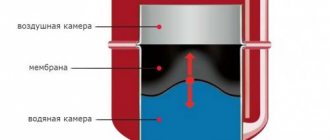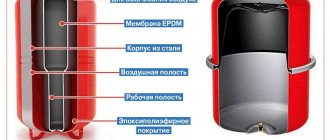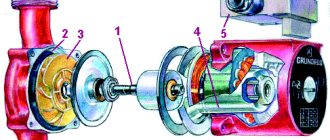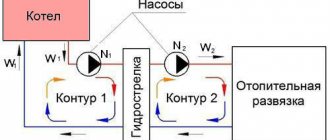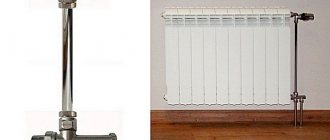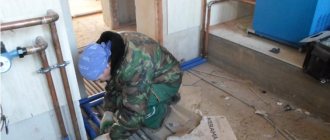When heating a private home, a fairly important issue is stabilizing the pressure in the boiler. If the pressure is low, the boiler will not be able to function. If the pressure is high, the heating equipment will wear out quickly. In order to stabilize the pressure, connect to the boiler expansion tank.
Expansion tank
Purpose of the expansion tank
An expansion tank is needed to compensate for the coolant pressure in the heating system. The pressure difference occurs due to changes in its temperature during the heating process, since its volume changes depending on the temperature.
Closed heating systems use an expansion tank of a closed, hermetically sealed structure. Inside the tank there is an elastic membrane that divides it into two parts. One of the parts of the tank contains air under pressure, the coolant penetrates into the second part.
The circulation of coolant in a closed heating system is ensured using a circulation pump. In an open heating system, a pump is not needed, and therefore any container can act as a tank, into which the coolant will be drained directly from the heating pipes.
Expansion tank in a closed heating system
Tank made of stainless steel or plastic container
An expansion tank can be easily built with your own hands. To do this, simply make a container that has the required volume. Often the tank is made of stainless steel sheet 2-4 mm thick. You can also use ready-made plastic containers. Before starting work, you need to prepare the necessary tools and materials.
Sheet layout
At the initial stage, the prepared sheet of metal is marked. First, a diagram of the future tank is drawn on paper. This will minimize waste. When cutting, it is worth considering that the grinder disc will take up several millimeters. After cutting, carefully clean all edges.
Cutting blanks
A grinder is used to cut metal. At this stage, you will need to prepare five or six blanks. The exact number of parts depends on the availability of the cover. If the tank is large, the lid can be divided in two. One part is tightly attached to the body, and the second is installed on the curtains.
Welding work
During connection, the workpieces are installed at right angles. In this case, welding can be carried out using different technologies. It all depends on the thickness of the metal. For workpieces made of 2 mm steel, gas welding is used. But, the connection of steel 4 mm thick is carried out using electric welding.
A hole is made in the bottom of the body (bottom), to which a pipe of the required diameter is welded. A pipe for supplying coolant will be connected to it in the future. The pipe is also connected to the general communication circuit.
Welding is carried out in different ways
Thermal insulation
As already noted, the tank is installed on top of the system. It is often installed in the attic. The peculiarity of such a room is that it is not heated. Therefore, the temperature in it is low, and sometimes even negative. This increases the risk of the water in the tank freezing. As a result, the system will not work and may be damaged.
To eliminate the occurrence of such a problem, experts recommend carrying out thermal insulation work in advance. To insulate the system, it is recommended to use special materials, such as basalt wool. It resists well the high temperature that is created when the container is heated.
Adding oil
In addition to the main one, other holes with pipes are made in the tank body, which perform certain functions. So, it is necessary to install an additional element through which coolant will be added to the tank. Another hole serves as an emergency drain for excess water or oil. The second end of the pipe is connected to a sewer or a separate tank.
Since the tank is not sealed, water will evaporate during the heating of the house. In addition, air may enter the system through the cap. This is fraught with overheating of the pipes and disruption of the normal circulation of the coolant. To prevent this, experts recommend adding a little oil to the tank. It will cover the surface of the water with a thin film, which will protect the system from air.
Volume calculation
When calculating the volume of the unit, it is worth considering many factors. The size of the tank is 5% of the amount of coolant in the system. In this case, add 2% for evaporation and 1% for reserve, which will prevent water from overflowing over the edges. If the system uses a different coolant, the value will be slightly different. It all depends on the coefficient of thermal expansion.
To determine the volume of the system, you need to sum up the volume of the pipes, battery and the boiler itself. You can also use a more simplified scheme. According to it, a boiler with a power of 1 kW is installed in systems with a volume of 15 liters.
Advantages of a closed heating system
- The first advantage of a closed heating system is that the tank can be installed wherever it is convenient for you, but in an open one, only in the attic or at some other high point in the system. And due to the tightness, the coolant practically does not evaporate.
- The coolant is always saturated with air in an open heating system, which leads to corrosion in heating pipes and radiators. In a closed environment, as you understand, this cannot happen.
- In a closed system, there are fewer losses in the tank than in an open system, which heats up very quickly and has increased sensitivity. Plus, the temperature difference in a closed system is smaller, which allows you to use heating equipment longer.
- The closed system is suitable for a wide variety of radiators, convectors and air curtains; you can connect a “warm floor” system. Plus, you can add an indirect heating boiler for domestic hot water to a closed system.
Expansion tank design
Tanks can be either with the ability to replace the membrane with a new one, or completely non-removable. To secure the tank to the wall, brackets and clamps may be included; to install the tank on the floor, special legs may be included. The tank membrane, in turn, can also be of different designs.
Non-separable models are equipped with a membrane in the form of a diaphragm; less commonly, a membrane in the form of a cylinder is found. It stretches under pressure, so it can be considered an independent water chamber. To replace this type of membrane, a special flange is used.
Expansion tank design
Calculation of tank volume
To determine the volume of the tank, you can follow the simplest path. That is, take 10% of the volume of coolant used, which is calculated at the design stage of the heating system. Or you can drain the old coolant and fill in a new one, measuring the volume with a meter.
You can also find out the volume of radiators and pipes, this way you will get the volume of the heating system, from which you will need to take 10%.
There is also a way to calculate the tank using the formula:
V=(E*C*(Pmax+1))/(Pmax+Pmin), where
E – coefficient of expansion of the coolant indicated on the packaging,
Pmax and Pmin are the maximum and minimum operating pressure of the system, respectively.
It should be said that for an open heating system no calculations need to be made, but for a closed one it is still worthwhile. Moreover, if the boiler already has a built-in tank, if its volume is insufficient, a new one is installed.
If there is insufficient tank volume, the volume of coolant decreases and the pressure in the heating system drops as it begins to drain into the sewer. If there is a critical shortage of coolant, the operation of the boiler may simply stall.
If you are at home at this moment, you will just need to add coolant. If you are not at home, the heating system will begin to defrost. And there is nothing good about operating a boiler in critical condition either.
Therefore, it is always better to carry out similar calculations and purchase a slightly larger tank than required.
Expansion tank pressure
Some boilers have the function of manually setting pressure using an expander. Otherwise, it should be approximately 0.3 atmospheres lower than the operating pressure of the heating system in a country private house. And it is usually equal to from 1.5 to 1.8 atmospheres, resulting in approximately 1.6 atmospheres maximum or 1.2 minimum.
To measure the pressure in the tank, connect the pressure gauge to the nipple at the top of the tank, under the plastic cap. Under the cover there is a spool through which excess pressure can be released. You just need to bend the plate and release the air to normal pressure.
To increase the pressure, the car pump along with a pressure gauge should be connected to the nipple, then pump to the required level. Do not forget that all these operations must be performed when the tank is disconnected from the heating system! The coolant must be completely drained.
Installed expansion tank
How and where to install the expansion tank
So, we are going to design and assemble a heating system with our own hands. If it also starts working, our joy will know no bounds. Are there instructions for installing the expansion tank?
Open system
In this case, the answer will be prompted by simple common sense.
An open heating system is, in essence, one large vessel of complex shape with specific convection currents in it.
The installation of a boiler and heating devices in it, as well as the installation of pipelines, must ensure two things:
- Rapid rise of water heated by the boiler to the top point of the heating system and its drainage through the heating devices by gravity;
- Unhindered movement of air bubbles to where they will rush in any vessel with any liquid. Up.
- Installation of a heating expansion tank in an open system is always carried out at its highest point. Most often - at the top of the accelerating manifold of a single-pipe system. In the case of top-fill houses (although you hardly have to design them) - at the top filling point in the attic.
- The tank itself for an open system does not need shut-off valves, a rubber membrane, or even a lid (except to protect it from debris). This is a simple water tank open at the top, into which you can always add a bucket of water to replace the evaporated water. The price of such a product is equal to the cost of several welding electrodes and a square meter of steel sheet 3-4 millimeters thick.
This is what an expansion tank for an open heating system looks like. If desired, a water tap from the water supply can be brought into the hatch in it. But much more often, as the water evaporates, it is topped up with an ordinary bucket.
Closed system
Here both the choice of tank and its installation will have to be taken quite seriously.
Let's collect and systematize the basic information available on thematic resources.
Installation of the expansion tank of the heating system is optimal in the place where the water flow is closest to laminar, where there is a minimum of turbulence in the heating system. The most obvious solution is to place it in the direct filling area in front of the circulation pump. In this case, the height relative to the floor or boiler does not matter: the purpose of the tank is to compensate for thermal expansion and dampen water hammer, and we can bleed the air through the air valves.
Typical tank installation diagram. Its location in a single-pipe system will be the same - in front of the pump along the flow of water.
- Factory equipped tanks are sometimes equipped with a safety valve that relieves excess pressure. However, it is better to play it safe and make sure that your product has it. If not, buy one and install it next to the tank.
- Electric and gas boilers with electronic thermostats are often supplied with a built-in circulation pump and heating expansion tank. Before you go shopping, make sure you need them.
- The fundamental difference between membrane expansion tanks and those used in open systems is their orientation in space. Ideally, the coolant should enter the tank from above. This subtlety of installation is designed to completely remove air from the compartment of the tank that is intended for liquid.
- The minimum volume of the expansion tank for a water heating system is taken approximately equal to 1/10 of the volume of coolant in the system. More is acceptable. Less is dangerous. The volume of water in the heating system can be roughly calculated based on the thermal power of the boiler: as a rule, 15 liters of coolant per kilowatt is taken.
- A pressure gauge mounted next to the expansion tank and the feed valve (connecting the heating to the water supply) can provide you with an invaluable service. The situation with a stuck safety valve spool, alas, is not so rare.
- If the valve releases pressure too often, this is a clear sign that you have miscalculated the volume of the expansion tank. There is no need to change it at all. It is enough to purchase another one and connect it in parallel.
- Water has a relatively low coefficient of thermal expansion. If you switch from it to a non-freezing coolant (for example, ethylene glycol), you will again need to increase the volume of the expansion tank or install an additional one.
The expansion tank in the photo is installed according to all the rules: the coolant is supplied from above, the tank is equipped with a pressure gauge and a safety valve.
Position of the expansion tank in the heating system
In a closed heating system, the tank should be installed after the boiler, but before the pump, to create a flow in the opposite direction. To connect the pump to the pipe, you need to install a tee; the tank is screwed onto a perpendicular outlet, which should have a vertical upward direction.
We recommend that you install the next tee after the tank so that a shut-off valve is installed on it. This way you can check the tank without draining the coolant. Turn off the tank and check the pressure, which should be at zero.
Summarizing all of the above, we can conclude that a closed heating system with an expansion tank is an almost universal solution for most types of boilers, radiators and other heating equipment.
Calculations for installing the tank are also highly recommended. An open heating system is mainly an option for a village house with an attic and a solid fuel boiler; in other situations such a scheme is of little use.
Open type expansion tank for heating systems
Large heating structures use expensive closed tanks.
They are characterized by a sealed housing with an internal rubber partition (membrane), thanks to which the pressure is adjusted when the coolant expands.
For full operation of home systems , an open type expansion tank is a suitable alternative that does not require special knowledge or professional training for operation and further repair of equipment.
An open tank performs several functions for the smooth operation of the heating mechanism:
- “takes away” excess heated coolant and “returns” cooled liquid back to the system to regulate pressure;
- removes air , which, thanks to the inclination of the pipes with a couple of degrees, itself rises to the open expansion tank located at the top point of the heating system;
- The open design feature allows you to add the evaporated volume of liquid directly through the top cap of the tank.
Operating principle
The workflow is divided into four simple steps:
- the tank is two-thirds full in normal condition;
- an increase in the flow of liquid into the tank and an increase in the filling level when the coolant is heated;
- liquid leaving the tank when the temperature drops;
- stabilization of the coolant level in the tank to its original position.
Design
The shape of the expansion tank exists in three versions: cylindrical, round or rectangular. There is an inspection cover on the top of the housing.
Photo 1. Open type expansion tank design for heating systems. The components are indicated.
The case itself is made of sheet steel , but with a homemade version, other materials are also possible, for example, plastic or stainless steel .
Reference.
The tank
is coated with an anti-corrosion layer to prevent premature destruction (primarily, this applies to iron containers).
The open tank system includes several different pipes:
- to connect the expansion pipe through which water fills the tank;
- at the junction of the overflow , for pouring out excess;
- when connecting a circulation pipe through which the coolant enters the heating system;
- for connecting a control pipe designed to eliminate air and adjust the fullness of pipes;
- spare , necessary during repairs to discharge coolant (water).
Volume
The correctly calculated volume of the tank affects the duration of operation of the joint system and the uninterrupted functioning of individual elements .
A small tank will lead to breakdown of the safety valve due to frequent operation, and a tank that is too large will require additional finances when purchasing and heating an excess volume of water.
The availability of free space will also be an influential factor .
Appearance
An open tank is a metal tank, the upper part of which is simply closed with a lid , with an additional hole for adding water. The tank body can be round or rectangular. The latter option is more practical and reliable during installation and fastening, but the round one has the advantage of sealed seamless walls.
Important! A rectangular tank requires additional reinforcement of the walls with an impressive volume of water (homemade version). This makes the entire expansion mechanism heavier, which must be lifted to the highest point of the heating system, for example, to the attic.
Advantages:
- Standard form. In most cases, it is a rectangle that can be installed and connected to the general mechanism yourself.
- A simple design without an excessive number of control elements, which makes it easy to control the smooth operation of the tank.
- The minimum number of connecting elements , which gives the body strength and reliability during operation.
- Average market price , thanks to the above facts.
In a water heating system, one of the components is an expansion tank. This is a small reservoir that is responsible for stabilizing pressure. Without it, damage to pipes, radiators and other system elements is possible. Let's talk further about what an expansion tank for heating is and how it regulates pressure.

